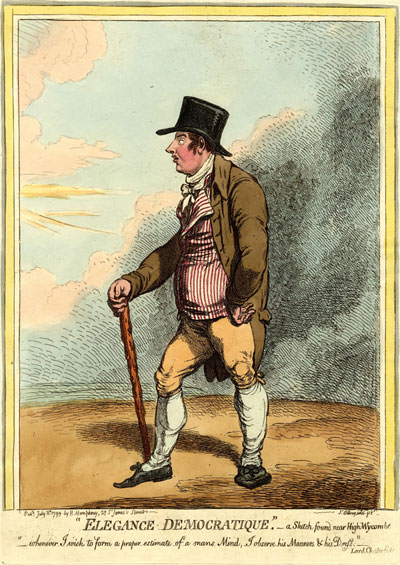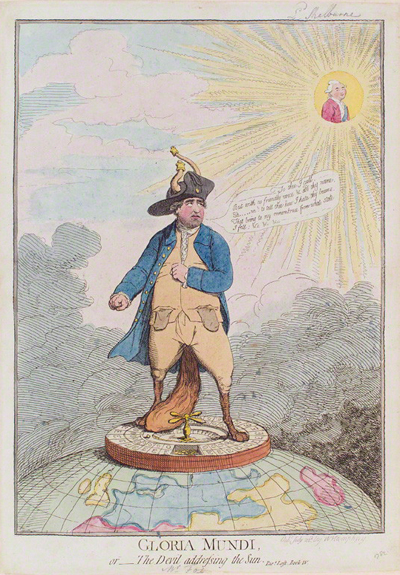"Elegance Democratique." A Sketch Found near High-Wycombe
Like many portrait caricatures, Elegance Democratique is a full length "sketch" of its subject against a basically blank or barely defined background. The head is in profile, but, in a variation of the standard, the body is turned slightly forward. And again, as in most portrait caricatures, the identity of the man is not directly stated but hinted at in the title, subtitle, and other details of the print.

[July 8, 1799]
© Trustees of the British Museum
From these clues, we can infer that this is John Henry Petty, the eldest son of Lord Lansdowne. The latter appeared frequently in Gillray's early caricatures as the shifty and suspicious Earl of Shelburne, the regular antagonist of Charles James Fox. Since 1786, John Henry had been a Member of Parliament representing his father's borough of High-Wycombe (hence the sub-title "A Sketch Found near High-Wycombe.")
Unlike his father, however, Wycombe (as he was called) was politically closer to Fox than Pitt. Having spent a considerable amount of time outside of England—in America, France, Switzerland and Italy—like Fox, he was supportive of the French revolution, and voted against the entry and continuance of the war with France. And though "he acquiesced in the motion for inquiry into corresponding societies. . . he claimed to be 'much inclined to defend those who are desirous of obtaining a parliamentary reform.'" In keeping with these republican leanings, the print's title is in French and the subject offers itself as an example of a democratic form of elegance
But of course everything about Wycombe's pose, his bearing, and his dress is tasteless and inelegant. He is round-shouldered and paunchy; he seems to slouch forward rather than standing erect, his stance seems almost a parody of classical contrapposto. His clothes are ill fitting and slovenly; his stockings slack. And the red and white stripes of his waistcoat clash with the browns of his coat and breeches.
To top off this critique of Wycombe and to help focus what we as viewers of the print should be looking for, Gillray includes a quotation attributed to one of the most famous arbiters of taste, Philip Stanhope, Lord Chesterfield."
Whenever I wish to Form a proper estimate of a mans (sic) Mind, I observe his Manners & his Dress.
I say "attributed" because, although the passage sounds like a quotation from Chesterfield and accurately reflects what Chesterfield might have thought and said, the words themselves are Gillray's. In addition to being a superb artist, Gillray had a great ear for language, and frequently imitated the style of others for satiric effect. In A Sphere Projecting Against a Plane (1792), for instance, he pretended to quote from Euclid's Elements even to the extent providing fictitious book and definition numbers. But the words are all Gillray's. Similarly, in portraying poor Tommy Paine in The Rights of Man (1791), Gillray creates a credible imitation of the mad stream of consciousness of poor Tom in Shakespeare's King Lear. And just a month earlier, Gillray had caught the bluff unvarnished tone of the proudly non-aligned Thomas Tyrwhitt Jones in the speech bubble accompanying Independence (1799).
The choice to parody Lord Chesterfield was, I believe, carefully calculated. Chesterfield's famously comprehensive and minutely detailed advice was contained in over 400 letters written over a 30 year period. Never intended for publication, the letters were addressed exclusively to his only (illegitmate) son in the hopes that he would learn from them "the Art of Becoming a Man of the World and a Gentleman." The project was not what one would call a success. Unwilling or unable to absorb his father's instruction, young Philip failed to rise as expected in the diplomatic corp, married secretly (and beneath him), and died early, at the age of 36, of dropsy.
As Gillray would certainly have heard, former prime minister Shelburne (aka the the Marquess of Lansdowne) had great expectations for his son which were also unfulfilled. Like Chesterfield he carefully groomed him to follow in his footsteps in a career in politics. Indeed, as Lady Holland later noted, Lansdowne seemed to want to make his son a tool for his own ambition, and to have a second vicarious career through him. At first, according to the History of Parliament, Wycombe seemed willing enough to follow his father's direction. But eventually, he came to resent Lansdowne's constant intrusion and distrust and to actively work against them. By March of 1798, he was writing to Lady Holland that "there is scarcely an error or misfortune in my life which I cannot trace up directly or indirectly to my father."
Looking back at Gillray's portrait of Wycombe, we can now see that there is a certain belligerence in Wycombe's awkward stance. With one hand on his hip as if to say "Try to make me!" and a club as a walking stick, he seems to express resistance against someone just outside the visual frame. And I can't help but wonder whether the rays of sun coming from the left of the print are meant to recall another confrontation with Shelburne/Lansdowne, Gloria Mundi when Lansdowne was also represented as the rays of the sun before someone who hated him.

© National Portrait Gallery, London.
Sources and Reading
- Commentary from the British Museum on "Elegance Democratique." A Sketch Found near High-Wycombe.
- "John Petty, 2nd Marquess of Lansdowne," Wikipedia
- "John Henry Petty," Dictionary of Irish Biography
- "William Petty, 2nd Earl of Shelburne," Wikipedia
- "John Henry Petty, Earl Wycombe," History of Parliament
- "Philip Stanhope, 4th Earl of Chesterfield," Wikipedia
- "Philip Stanhope (diplomat)," Wikipedia
- Thomas Wright and R.H. Evans, Historical and Descriptive Account of the Caricatures of James Gillray #504.
- Thomas Wright and Joseph Grego, The Works of James Gillray, the Caricaturist; With the History of His Life and Times, p. 266.
Comments & Corrections
NOTE: Comments and/or corrections are always appreciated. To make that easier, I have included a form below that you can use. I promise never to share any of the info provided without your express permission.